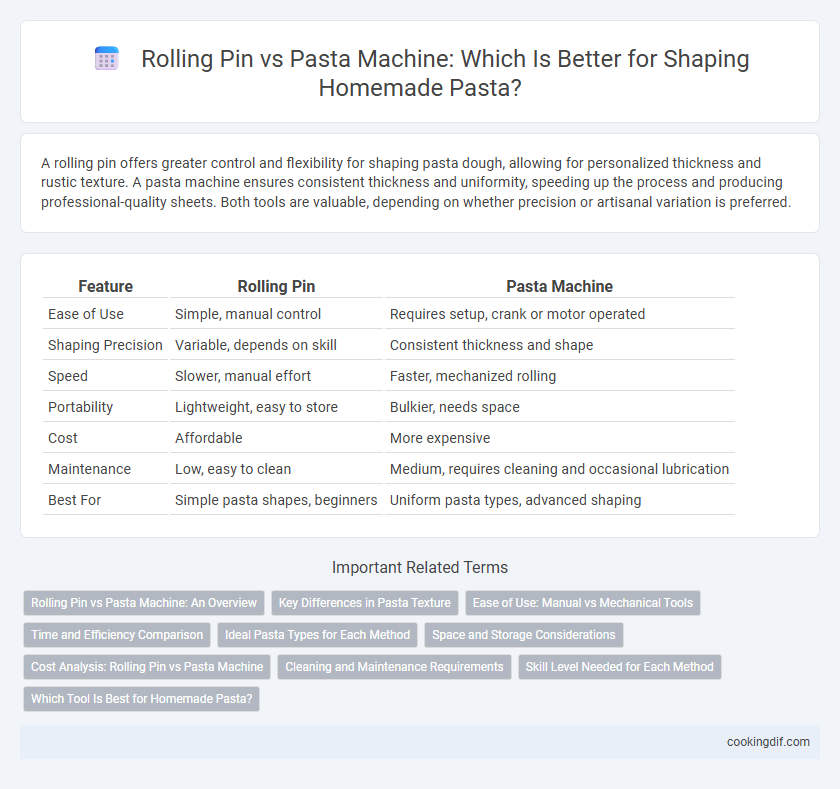A rolling pin offers greater control and flexibility for shaping pasta dough, allowing for personalized thickness and rustic texture. A pasta machine ensures consistent thickness and uniformity, speeding up the process and producing professional-quality sheets. Both tools are valuable, depending on whether precision or artisanal variation is preferred.
Table of Comparison
| Feature | Rolling Pin | Pasta Machine |
|---|---|---|
| Ease of Use | Simple, manual control | Requires setup, crank or motor operated |
| Shaping Precision | Variable, depends on skill | Consistent thickness and shape |
| Speed | Slower, manual effort | Faster, mechanized rolling |
| Portability | Lightweight, easy to store | Bulkier, needs space |
| Cost | Affordable | More expensive |
| Maintenance | Low, easy to clean | Medium, requires cleaning and occasional lubrication |
| Best For | Simple pasta shapes, beginners | Uniform pasta types, advanced shaping |
Rolling Pin vs Pasta Machine: An Overview
A rolling pin offers manual control and versatility for shaping pasta dough, allowing for variable thickness and texture adjustments through hands-on pressure. Pasta machines provide consistent, uniform sheets of pasta quickly, with adjustable settings for thickness and ease of use in producing standard pasta shapes. Choosing between a rolling pin and a pasta machine depends on desired precision, speed, and traditional technique preferences.
Key Differences in Pasta Texture
A rolling pin produces pasta dough with a slightly uneven, rustic texture due to manual pressure variations, enhancing sauce adhesion and chewiness. In contrast, a pasta machine creates uniformly thin sheets, resulting in a smoother, more consistent texture ideal for delicate pasta types like lasagna or fettuccine. Texture differences influence cooking time and mouthfeel, with rolling pin pasta often yielding a heartier bite.
Ease of Use: Manual vs Mechanical Tools
Rolling pins offer a straightforward, tactile approach to shaping pasta dough, allowing precise control over thickness with simple manual pressure. Pasta machines leverage mechanical rollers powered by hand cranks or motors, providing consistent, even sheets more efficiently for larger batches. For beginners, rolling pins require less setup and are easier to clean, while pasta machines demand initial familiarization but significantly reduce effort and time during repeated pasta shaping tasks.
Time and Efficiency Comparison
A pasta machine shapes dough more quickly and consistently than a rolling pin, significantly reducing preparation time for pasta making. Rolling pins require manual effort to achieve uniform thickness, which can be time-consuming and less efficient, especially for larger batches. For home cooks seeking speed and precision, a pasta machine offers superior efficiency in shaping pasta dough.
Ideal Pasta Types for Each Method
Rolling pins excel in shaping thicker, rustic pasta types like fettuccine and pappardelle due to precise manual control over dough thickness. Pasta machines deliver consistent thin sheets ideal for delicate varieties such as lasagna and angel hair, ensuring uniform texture essential for even cooking. Selecting the right tool enhances dough elasticity and final pasta quality tailored to specific shapes and sauces.
Space and Storage Considerations
Choosing between a rolling pin and a pasta machine significantly impacts kitchen space and storage efficiency. Rolling pins are compact, lightweight, and easily stored in drawers or hung on hooks, making them ideal for small kitchens with limited storage. Pasta machines, while providing uniform pasta sheets, require more countertop space and dedicated storage, which can be challenging in kitchens with restricted room.
Cost Analysis: Rolling Pin vs Pasta Machine
A rolling pin offers a budget-friendly option for shaping pasta, with prices typically ranging from $10 to $30, making it accessible for beginners or occasional cooks. Pasta machines, costing between $30 and $150 depending on brand and features, provide consistent thickness and ease of use, justifying the higher investment for frequent pasta makers. Considering durability and precision, pasta machines may offer better long-term value despite the upfront cost difference.
Cleaning and Maintenance Requirements
Rolling pins require minimal cleaning, usually just a quick wipe with a damp cloth and occasional flouring to prevent dough from sticking, making maintenance straightforward. Pasta machines need careful cleaning by hand to avoid water damage and rusting, requiring disassembly and brushing out flour residue without using water on metal parts. Regular oiling of machine parts extends their lifespan, whereas rolling pins demand less routine upkeep but may require seasoning if wooden.
Skill Level Needed for Each Method
Using a rolling pin to shape pasta requires moderate skill, as it demands manual control over thickness and uniformity, which can be challenging for beginners. A pasta machine simplifies this process by offering adjustable rollers that ensure consistent thickness, making it ideal for novice to intermediate cooks. Expert chefs often prefer rolling pins for greater tactile feedback and artisanal texture in handmade pasta sheets.
Which Tool Is Best for Homemade Pasta?
Choosing between a rolling pin and a pasta machine depends on the desired pasta texture and consistency. A pasta machine offers uniform thickness and speed, ideal for producing smooth, even sheets for lasagna or ravioli, while a rolling pin provides greater control and a rustic texture suited for hand-shaped pasta like pici or mafaldine. For consistent results and ease of use, especially with thin pasta dough, a pasta machine generally outperforms manual rolling pins.
Rolling pin vs pasta machine for shaping Infographic

 cookingdif.com
cookingdif.com